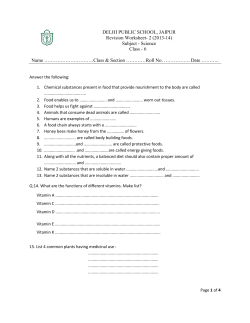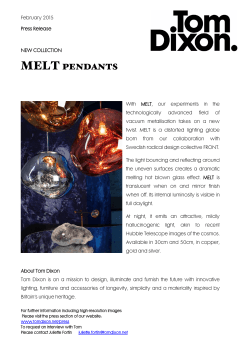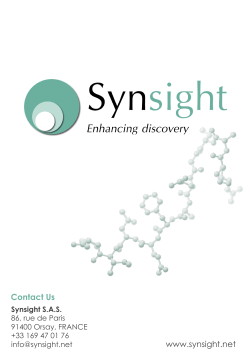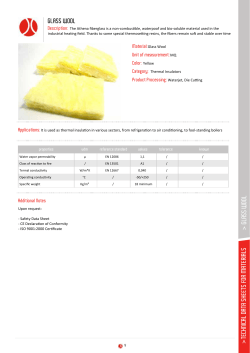
1030 Experiment No. 12, Classification of Chemical Substances
General Chemistry I CHEM-1030 Laboratory Experiment No. 12 Classification of Chemical Substances (revised 05/29/2015) Introduction Depending on the kind of bonding present, a chemical substance may be classified, among other ways, as ionic, molecular, macromolecular or metallic. In an ionic compound, the large electrostatic forces between positively and negatively charged ions hold the particles strongly together. In a molecular substance, molecules form by sharing electrons between atoms. However, the forces between molecules may be relatively weak. When the molecules resulting from covalent bonding contain relatively small numbers of atoms, the substances are molecular. If the particles are very large and include essentially all the atoms in a macroscopic particle, the substance is called macromolecular. Metals are characterized by bonding in which the electrons are much freer to move than in other kinds of substances. The metallic bond is strong and stable but less localized than other types of bonds. The terms ionic, molecular, macromolecular and metallic are somewhat arbitrary. Some substances have borderline properties that place them between two groups. A common borderline designation is molecular-ionic. Most of the time you should look for the characteristics of the more common ionic, molecular, macromolecular and metallic categories. However, you may find a few substances whose properties fall between those of two categories. Ionic Substances Ionic substances are usually solids at room temperature. (Recently, ionic liquids have been prepared by designing huge cations with a single positive charge in the center. A large cation diameter increases the distance between the cation and anion centers and reduces their electrostatic attraction for each other. This gives the ions more mobility and allows the compounds to exist as room temperature liquids.) Normal ionic solids are typically crystalline, but may exist as fine powders as well as clearly defined crystals. While many ionic substances are stable up to their melting points, some decompose on heating. It is common for an ionic crystal to release loosely bound waters of hydration at temperatures below 200 C. Anhydrous (dehydrated) ionic compounds have high melting points, usually between 300 C and 1000 C. They boil only at very high temperatures. They may or may not be soluble in water. If they are water soluble, the resulting solutions conduct electric current. Solid ionic compounds do not conduct electricity because their ions are locked in the crystal lattice. When an ionic substance melts or dissolves in water, the ions become mobile, allowing the solutions to conduct. Examples of ionic solids are all the common salts such as NaCl, KNO3, Li2SO4, CaI2, etc. Molecular Substances All gases and essentially all room temperature liquids are molecular in nature. The diatomic gases, Cl 2, O2, H2, N2, F2 and most binary compounds composed of two nonmetals, such as SO2, CO2, CCl4 and SF6 are molecular. The molecular substance water can exist as a solid, liquid or vapor under ordinary conditions. If the formula mass of a molecular substance exceeds about 100 g/mol, it may be a room temperature solid. The melting points of molecular substances are usually below 300 C. These substances may also 1 be volatile, but some larger molecules such as glucose decompose before they melt or boil. Most molecular substances do not conduct electric current when solid or molten or in aqueous solution because they are not composed of ions. Organic compounds, which primarily contain carbon and hydrogen, often combined with other nonmetals, are usually molecular in nature. If an organic compound decomposes on heating, it usually leaves a black carbonaceous residue. (Think of charred sugar.) Organic molecular substances are frequently soluble in some organic solvents, especially if the substance and the solvent have similar molecular structures. Organic molecular substances include all the hydrocarbons such as hexane (C6H14), benzene (C6H6), paraffin wax (a typical formula is C31H64); common solvents such as acetone (C3H6O) and ethyl alcohol (C2H6O); carbohydrates such as glucose (C6H12O6), sucrose and ribose; organic acids such as acetic acid, citric acid, and stearic acid. Molecular-Ionic Substances Some molecular compounds are markedly polar, with increased solubility in water and other polar solvents. Other substances, for instance acetic acid and many other organic weak acids, may ionize slightly in water, or in the melt, and become conductors of electricity. Often the conductivity is considerably lower than that of an ionic material. Most polar molecular compounds in this category are organic, but a few, including some transition metal salts, are inorganic. These substances, which may have low melting points yet conduct electricity in solution and in the melt, belong to the molecular-ionic subcategory. Macromolecular Substances Macromolecular, or network covalent, substances are all solids at room temperature. They occur in two principal forms, inorganic and organic. a) Inorganic macromolecular substances have very low volatility and very high melting points usually above 1000 C. They have low volatility and are very resistant to thermal degradation. With the exception of the graphite form of carbon, they do not conduct electricity and are often good insulators. They are not soluble in any solvents. They are hard and chemically inert and are often used as abrasives and for cutting tools. Because of their hardness, pieces of inorganic macromolecular substances are difficult to crush and usually have sharp, well-defined edges. Examples are silica (SiO2), carborundum (SiC) and the diamond form of carbon. b) Organic macromolecules include the common polymeric plastics such as Bakelite, polypropylene, synthetic rubber, phenol formaldehyde resin, neoprene, nylon, Teflon, polyvinyl chloride (PVC or vinyl), polystyrene, polyethylene, polyacrylonitrile and silicone resins. While these macromolecules are typically nonvolatile and have melting points much higher than their constituent monomers, they will all degrade at temperatures substantially below 1000 C. Degradation can take the form of charring, ignition, decomposition to their constituent monomers and decomposition to volatile breakdown products. (Note: Biologically active macromolecules such as proteins, polysaccharides and nucleic acids will not be studied in this experiment.) Like inorganic macromolecules, the common plastics do not conduct electricity and are insoluble in most solvents. Organic macromolecular substances are usually much softer than inorganic ones. When they are heated to high temperatures, organic macromolecules may show some melting or charring. If they do char, you may see some smoke or be able to detect the odors of their decomposition products. 2 Metallic Substances The properties of metals derive mainly from the mobility of their bonding electrons. Metals are good electrical conductors both in the solid and liquid form, and have characteristic luster and malleability. All metals but mercury are solids at room temperature and have melting points that range from 30 C to over 2000 C. They are not soluble in water or organic solvents. Some metals are prepared as black powders, which may not appear to be electrical conductors; if such powders are heated, the particles coalesce to solids with good electrical conductivity. Table 1 lists some properties of 17 representative solids. Experimental Refer to the data table (Table 2) on page 6. You will work with six “known” substances (labeled A through F) and two numbered unknown solids. Your instructor may or may not supply the chemical names of the known substances. Test each of the eight solids for electrical conductivity in the solid state, approximate melting range, electrical conductivity in the liquid state (melt), water solubility and electrical conductivity in aqueous solution as outlined in steps 1-10. From your data and the information given in this introduction, classify each known solid as either: Ionic, Molecular, Molecular-Ionic, Inorganic Macromolecular, Organic Macromolecular or Metallic. Your instructor will check your conclusions for the known substances before you leave the laboratory. Your report will be graded on how you classify your unknowns and on the answers to the report questions. 1. Choose one of the six known solids. Weigh about 1.0 g onto a clean, dry watch glass. If single large pieces of the solid are available, take one piece instead of weighing a sample. 2. Test the conductivity of the solid on the apparatus demonstrated by the instructor. If the solid is a powder, make sure both “feet” of the conductivity apparatus contact the powder. If solid is in large pieces, clamp or squeeze a piece between the electrodes to make good electrical contact. Record the conductivity in volt or milliamp units as determined by the meter and specified by the instructor. 3. Place the watch glass with the same solid on a hot plate set to low heat. Let it sit for 5 minutes. If the solid melts, its melting point is below about 300 C. If the solid does not melt in 5 minutes, transfer the watch glass to a hot plate set to medium heat. (To move a hot watch glass safely, grasp it with tongs and slide a wire gauze square under the glass for support. If the solid melts after 10 min at medium heat, its approximate melting range is 300 – 600 C. If it does not melt, assume its melting point is above 600 C. 4. If a solid melts on either hotplate, test the melt conductivity. Make sure the substance is still a liquid. If it starts to solidify, melt it again and quickly measure its conductivity. If the solid did not melt in step 3, do not attempt to test its conductivity again. Simply put a large X in the Conductivity as Melt box in the data table to indicate that you could not do the procedure. 5. Discard the solid as directed by your instructor, either as heavy metal waste or organic waste. 6. Weigh about 0.2 g of a fresh sample of the same solid into a 50 mL beaker. Add 10 mL of distilled or deionized water and stir. Does the solid dissolve or not? 3 7. If the solid dissolves, test the solution conductivity. (Note: To evaluate the electrical conductivity of an aqueous solution, do not consider just its conductivity reading. Compare the solution conductivity to that of distilled water, which is not necessarily zero. It is the conductivity difference between distilled water and a solution that is significant. If the solid does not dissolve in step 6, do not attempt to test its solution conductivity. Put a large X in the Solution Conductivity data box to show you did not do the procedure. Discard the solutions and solid-water mixtures as heavy metal waste or as otherwise directed by your instructor. 8. Repeat steps 1 through 7 for the remaining five known solids. 9. Classify each of the six known substances and ask the instructor to approve your data sheet. 10. Obtain two unknown solids and perform steps 1 through 7 with each unknown. When you have finished testing your unknowns, check with your instructor for the correct disposal procedure. Safety Chemical splash goggles and a waterproof apron must be worn at all times during this and all chemistry experiments, from the very beginning to the very end of the time you spend in the laboratory. Waste Disposal Your instructor will provide disposal information for each substance used in this experiment. Enter each disposal method in the far right column of Table 2, your data sheet. Remember: few chemicals can be legally or safely thrown in the trash or poured down a sink drain. Toxic metal compounds, concentrated acids and concentrated bases must be disposed of in the laboratory heavy metal hazardous waste collection container. Organic compounds, many of which are toxic or flammable, are properly disposed of as organic hazardous waste. Cleanup Before you leave the lab, wipe down all your work surfaces with a damp sponge. 4 Table 1 ─ Physical Properties and Classification of Some Representative Substances Substance Appearance NaCl White cubic crystals MgO White Powder Melting Pt (C) Boiling Pt (C) Solubility in H2O 801 1413 soluble 2800 3600 slightly soluble CoCl2 Blue Crystals 735 1049 soluble Polyvinyl chloride (C2H3Cl)n White solid 100 to 260 dec. insoluble 70 255 113 445 327 dec. 0 100 — 122 249 slightly soluble 17 119 soluble 306 dec. soluble C10H8 Sulfur (S8) Teflon (CF2)n H2O C6H5COOH CH3COOH FeCl3 C (diamond) C (graphite) SiO2 B4C Fe Al White Crystals Yellow Crystals Yellow Powder White Solid Clear Crystals Clear Liquid White Crystals Clear liquid Red or Green Solid Clear to Brown Solid Black Solid Clear Glassy Crystals Gray to Black Solid Silvery solid or Gray Powder Silvery Solid insoluble insoluble insoluble insoluble >3500 insoluble >4200 1600 2590 2350 >3500 1535 3000 933 2470 insoluble insoluble insoluble insoluble Electrical Conductivity zero in solid high in melt high in soln zero in solid low in soln zero in solid high in melt high in soln zero in solid zero in melt zero in solid zero in melt zero in solid zero in melt zero in solid zero in melt zero in solid low in melt zero in solid low in soln. zero in solid high in soln. zero in solid high in soln. zero in solid zero in melt high in solid zero in solid zero in melt zero in solid zero in melt high in solid high in melt high in solid high in melt Classification ionic ionic ionic organic macromolecular molecular molecular organic macromolecular molecular molecular-ionic molecular-ionic molecular-ionic inorganic macromolecular inorganic macromolecular inorganic macromolecular inorganic macromolecular metallic metallic Symbols and Abbreviations: soluble (at least 0.1 mol/L), slightly soluble (appreciable solubility but <0.1 mol/L), soln – solution, dec – decomposes 5 Table 2 ─ Classification of Chemical Substances Data Page Measured Conductivity of Distilled Water alone: __________ Substance A B C D Visual Appearance Conductivity as Solid Melted on Low Hotplate? Melted on Medium Hotplate? Approx. Melting Range Conductivity as Melt Solubility in water (yes or no) Solution Conductivity Reading Classification Disposal Method 6 E F Unknown Number Unknown Number General Chemistry I CHEM-1030 Laboratory Experiment No. 12 Classification of Chemical Substances Report 1. What is the classification of your first unknown? Unknown Number____________ For full credit, clearly explain all the reasons for your conclusion. (8 points) 2. Using your chemistry text or other suitable print or on-line reference, give the names and chemical formulas of two substances not listed or mentioned in this laboratory writeup that share the same classification and general properties (melting point, etc.) as your first unknown. (2 points) 7 3. What is the classification of your second unknown? Unknown Number____________ For full credit, clearly explain all the reasons for your conclusion. (8 points) 4. Using your chemistry text or other suitable print or on-line reference, give the names and chemical formulas of two substances not listed or mentioned in this laboratory writeup that share the same classification and general properties (melting point, etc.) as your second unknown. (2 points) 8 1. General Chemistry I CHEM-1030 Laboratory Experiment No. 12 Classification of Chemical Substances Prestudy Describe two experiments you could use to distinguish between an ionic solid and a macromolecular solid. (2 points) 2. A certain solid does not conduct electricity in either the solid or the molten state. It is insoluble in water and melts around 101C. How would you classify the substance? Explain the reasons for your answer. (2 points) 3. A solid melts at 29.7 C. It conducts electricity in both the solid and molten states. It is insoluble in water. How would you classify the substance? Explain the reasons for your answer. (2 points) 4. A solid does not conduct an electric current. It melts at 449C and the melt conducts electricity. The solid is soluble in water. How would you classify the substance? Explain the reasons for your answer. (2 points) 5. A solid does not conduct electricity in the solid state. When melted at a temperature greater than 1870C, the melt also does not conduct electricity. The solid is insoluble in water. How would you classify the substance? Explain the reasons for your answer. (2 points) 9
© Copyright 2025








